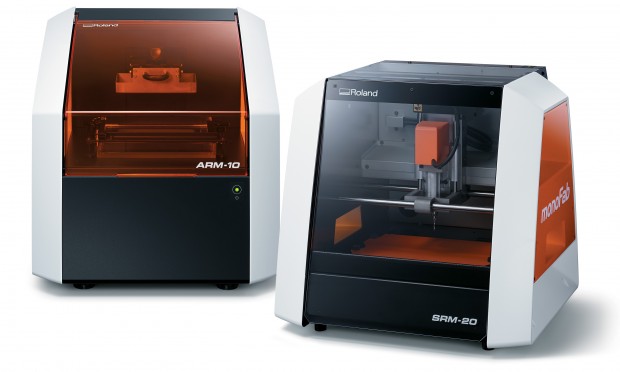Editor’s Pick: Roland DGA Unveils Its First 3D Printer, New Milling Machine

Roland DGA has released the monoFab series of complementary desktop fabrication tools, the ARM-10 (left) 3D printer and the SRM-20 (right) subtractive milling machine. Image courtesy of Roland DGA Corp.
September 11, 2014
 Dear Desktop Engineering Reader:
Dear Desktop Engineering Reader:
 Roland DGA has been manufacturing 3D milling machines for about 28 years now. They know their stuff. They’re also well known throughout the CAD/CAM and graphics arts industries for their wide-format printers, cutting and engraving machines, 3D scanners, support software and user support. One thing that they are not well known for, however, is 3D printing. That is about to change.
Roland DGA has been manufacturing 3D milling machines for about 28 years now. They know their stuff. They’re also well known throughout the CAD/CAM and graphics arts industries for their wide-format printers, cutting and engraving machines, 3D scanners, support software and user support. One thing that they are not well known for, however, is 3D printing. That is about to change.
Roland DGA just released what it calls the monoFab series of desktop fabrication systems. The series is comprised of two machines: the monoFab SRM-20 subtractive milling machine and the monoFab ARM-10, the company’s first ever 3D printer. The idea behind the series is to offer designers and engineers a set of desktop tools that lets them integrate the additive manufacturing capabilities of 3D printing with the precision subtractive fabrication capabilities of milling. This means you can make, say, complex external parts with the 3D printer and precision parts with the milling machine, then mate them for a more realistic prototype of a functional model.
Let me clarify here: You don’t have to acquire the machines as a set. I asked a company spokesperson about that to be sure. But going for both is not out of the question by a long shot. A tricked-out engineering workstation can run you at least as much as these two units combined. Individually, they are cost-comparable with your average mid-range CAD software application.
So, what have you with the monoFab series? Let’s start with the ARM-10 desktop 3D printer. It’s designed for concept modeling and form testing applications. It’s a stereolithographic system that builds your models using a proprietary UV-LED projection system to cure individual layers of liquid resin. You can watch models being built layer by layer through its translucent front panel.
The ARM-10 has a good-sized build area that can accommodate making multiple objects simultaneously. Build area specs are 5.11 (130 mm) W x 2.75 (70 mm) D x 2.75 in. (70 mm) H. Resolution specs are 0.00079 in. (0.2 mm) for the X and Y axes and 0.0004 in. (0.01 mm) for the Z-axis. The ARM-10 comes with software to support 3D printing tasks beyond slicing an STL file such as automatic support building, healing and mesh simplification, simulation of resin volume and various controls. It also has a layer preview functionality.
The fully enclosed SRM-20 subtractive milling machine has a see-thru front panel and a side window that should be handy when you need to adjust the Z-axis or just want another angle to check in on progress during an operation. The SRM-20 gives you the flexibility to work with an assortment of materials, including ABS (acrylonitrile butadiene styrene), acrylic, chemical wood, foam and modeling wax. It has an independent collet system chuck so that you can replace the collet chuck to match the shank diameter easily. This also should make setting of the Z-axis base point and tool changes fast. You can adjust the spindle rotation speed from 3,000 to 7,000 rpm.
The SRM-20 comes with all sorts of software for processing STL files, milling holes and shapes as well as finishing processes. One application, called Virtual MODELA, gives you quick previews of your milling operation, finished shapes simulations and production time estimates. You communicate with the SRM-20 through its VPanel computer controller. This feature has a simple, nonthreatening interface and virtual sliders, buttons and so forth for adjusting the tool position, setting milling starting points, controlling feed rates and other milling tasks.
You can learn about the monoFab series ARM-10 stereolithographic 3D printer and the SRM-20 milling machine in today’s Pick of the Week write-up and the informational links at the end. Make sure to download the brochure. It has the complete specs as well as a brief testimonial from a product designer who used both systems to take his design concepts from idea to validation quickly. Essentially, he used the ARM-10 to 3D print the complex parts and the SRM-20 to make precision parts. Good stuff.
Thanks, Pal. — Lockwood
Anthony J. Lockwood
Editor at Large, Desktop Engineering
Read today’s pick of the week write-up.
This is sponsored content. Click here to see how it works.
Subscribe to our FREE magazine, FREE email newsletters or both!
About the Author
Anthony J. Lockwood is Digital Engineering’s founding editor. He is now retired. Contact him via [email protected].
Follow DE





